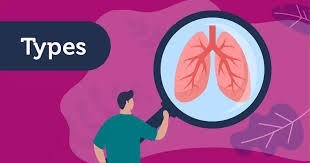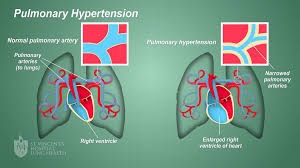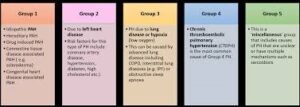Types of Pulmonary Hypertension

Pulmonary hypertension (PH) is a complex condition characterized by elevated blood pressure in the pulmonary arteries, which can lead to serious health complications. Understanding the various classifications of pulmonary hypertension is crucial for effective diagnosis and treatment. This article discusses the different types of pulmonary hypertension, including idiopathic pulmonary hypertension, pulmonary hypertension associated with lung diseases, and pulmonary hypertension related to heart diseases.
Overview of Pulmonary Hypertension

Pulmonary hypertension occurs when the pressure in the pulmonary arteries rises above normal levels, typically defined as exceeding 25 mmHg at rest. Normal pressure ranges from 8 to 20 mmHg. The condition can lead to symptoms such as shortness of breath, fatigue, chest pain, and swelling in the legs and abdomen. Identifying the specific type of pulmonary hypertension is essential for determining the appropriate treatment strategy.
Classification of Pulmonary Hypertension

The World Health Organization (WHO) classifies pulmonary hypertension into five main groups based on the underlying cause:
- Group 1: Pulmonary Arterial Hypertension (PAH)
- Group 2: Pulmonary Hypertension due to Left Heart Disease
- Group 3: Pulmonary Hypertension due to Lung Disease and/or Hypoxia
- Group 4: Chronic Thromboembolic Pulmonary Hypertension (CTEPH)
- netfGroup 5: Pulmonary Hypertension with Unclear Multifactorial Mechanisms
Let’s explore each group in detail.
Group 1: Pulmonary Arterial Hypertension (PAH)
Definition
Pulmonary arterial hypertension (PAH) is characterized by high blood pressure in the pulmonary arteries due to various causes. It is often idiopathic, meaning the cause is unknown, but can also be hereditary or linked to certain risk factors.
Types of PAH
- Idiopathic PAH: The exact cause is unknown. It can occur in young adults and is often progressive.
- Heritable PAH: Genetic mutations, especially in the BMPR2 gene, can lead to familial forms of PAH.
- Drug and Toxin-Induced PAH: Certain medications, such as appetite suppressants and some chemotherapy drugs, can induce PAH.
Symptoms
Symptoms of PAH may include:
- Shortness of breath, particularly during exertion
- Fatigue and weakness
- Chest pain
- Swelling in the legs and ankles
Treatment
Treatment options may include:
- Endothelin receptor antagonists (e.g., bosentan)
- Phosphodiesterase-5 inhibitors (e.g., sildenafil)
- Prostacyclin analogues (e.g., epoprostenol)
- Oxygen therapy in cases of low oxygen levels
Group 2: Pulmonary Hypertension due to Left Heart Disease
Definition
This type of pulmonary hypertension arises due to increased pressures in the left heart, which subsequently elevate pressure in the pulmonary circulation. It is the most common cause of pulmonary hypertension.
Causes
- Left Ventricular Systolic Dysfunction: Conditions like heart failure reduce the heart’s ability to pump effectively.
- Left Ventricular Diastolic Dysfunction: Impaired filling of the heart’s left ventricle can lead to increased pressures.
- Valvular Heart Disease: Conditions affecting the heart valves, such as mitral stenosis, can also contribute.
Symptoms
Symptoms are often related to heart failure and may include:
- Shortness of breath
- Fatigue
- Swelling in the abdomen and extremities
Treatment
Management primarily focuses on treating the underlying heart condition, which may involve:
- Medications: Diuretics, ACE inhibitors, and beta-blockers.
- Surgical interventions: Valve repair or replacement.
Group 3: Pulmonary Hypertension due to Lung Disease and/or Hypoxia
Definition
This type of pulmonary hypertension is associated with chronic lung diseases or conditions that result in low oxygen levels.
Causes
Common causes include:
- Chronic Obstructive Pulmonary Disease (COPD): A major contributor to pulmonary hypertension.
- Interstitial Lung Disease: Conditions like pulmonary fibrosis lead to scarring and increased pulmonary pressures.
- Sleep Apnea: This condition causes intermittent hypoxia, contributing to pulmonary hypertension.
Symptoms
Symptoms are often similar to those of the underlying lung disease:
- Shortness of breath
- Chronic cough
- Fatigue
Treatment
Management includes:
- Oxygen therapy to maintain adequate oxygen levels.
- Treatment of the underlying lung disease with bronchodilators, corticosteroids, or other medications.
- Pulmonary rehabilitation to improve exercise capacity and quality of life.
Group 4: Chronic Thromboembolic Pulmonary Hypertension (CTEPH)
Definition
CTEPH results from chronic blood clots that obstruct the pulmonary arteries, leading to increased pressure.
Causes
- Pulmonary Embolism: Recurrent or unresolved pulmonary emboli can result in chronic obstruction and subsequent pulmonary hypertension.
Symptoms
Symptoms of CTEPH can include:
- Shortness of breath, especially with exertion
- Fatigue
- Chest pain
Treatment
CTEPH may be managed with:
- Anticoagulation therapy to prevent further clot formation.
- Surgical intervention: Pulmonary thromboendarterectomy (PTE) may be performed to remove blood clots.
- Balloon pulmonary angioplasty: A less invasive option for some patients.
Group 5: Pulmonary Hypertension with Unclear Multifactorial Mechanisms
Definition
This group encompasses pulmonary hypertension with various causes that do not fit into the other classifications.
Causes
Conditions may include:
- Sarcoidosis: An inflammatory disease that can affect the lungs and lead to pulmonary hypertension.
- Hematological Disorders: Such as sickle cell disease or essential thrombocythemia.
- Metabolic Disorders: Conditions like thyroid disease can also contribute.
Symptoms
Symptoms vary based on the underlying condition but often include:
- Shortness of breath
- Fatigue
- Swelling in the legs
Treatment
Management depends on the underlying cause and may involve:
- Treatment of the primary condition.
- Medications to relieve pulmonary hypertension symptoms.
Conclusion.
It is a multifaceted condition that requires accurate classification for effective treatment. Understanding the different types of pulmonary hypertension—idiopathic pulmonary hypertension, pulmonary hypertension associated with lung diseases, and pulmonary hypertension linked to heart diseases—enables healthcare providers to tailor management strategies to each patient’s needs.
Raising awareness about pulmonary hypertension and its various classifications is crucial for early detection and intervention. Individuals experiencing symptoms of pulmonary hypertension should seek medical attention promptly to improve outcomes and enhance quality of life.
References:
- Simonneau, G., et al. (2019). “Haemodynamic Definitions and Updated Clinical Classification of Pulmonary Hypertension.” European Respiratory Journal, 53(1), 1802067.
- Pulmonary Hypertension Association. (2023). “Understanding Pulmonary Hypertension.” Retrieved from phassociation.org
- National Heart, Lung, and Blood Institute. (2022). “Pulmonary Hypertension.” Retrieved from nhlbi.nih.gov
- McLaughlin, V. V., et al. (2015). “Pulmonary Hypertension: A New Era.” Circulation Research, 116(5), 1-3.
- American Heart Association. (2023). “What Is Pulmonary Hypertension?” Retrieved from heart.org
Written by Fawzi Rufai, Medically Reviewed by Sesan Kareem